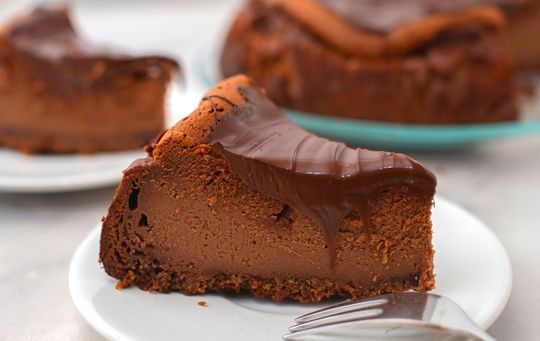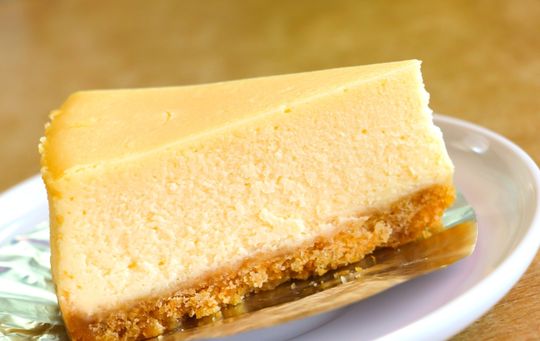Cheesecake is a beloved dessert enjoyed by many people around the world. It is rich, creamy, and indulgent, and can be enjoyed in a variety of flavors and styles. One thing that sets cheesecake apart from other desserts is the way it is cooked – specifically, by being placed in a pan of water during the baking process.
Why Do You Cook Cheesecake in a Pan of Water? Cooking cheesecake in a water bath, or bain-marie, helps regulate the temperature and adds moisture to the oven, ensuring gentle and even baking. This method prevents the cheesecake from overcooking, cracking, or drying out, resulting in a creamy and perfectly textured dessert.

Why do you cook cheesecake in a pan of water – Explained
There are various benefits to baking cheesecake in a water bath, often known as a bain-marie.
A more equal and moderate heat source that helps control the cheesecake’s temperature and prevents it from cracking or drying out too much is provided by the water bath.
A harsh or rubbery texture for the cheesecake can also be avoided thanks to the wet atmosphere of the water bath.
Overall, a handmade cheesecake’s texture and look can be enhanced by employing a water bath, which is a straightforward method.
What is a Water Bath?
A water bath, also known as a bain-marie, is a cooking technique in which a food item is placed in a pan or dish, which is then placed in a larger pan filled with hot water.
The water bath helps to evenly distribute heat around the food, preventing it from cooking too quickly on the outside while still ensuring that it is cooked through.
The use of a water bath is common in cooking and baking, and it is particularly useful for dishes that require a gentle, even heat, such as custards, flans, and cheesecakes.
The water bath helps to prevent the edges of the cheesecake from cooking too quickly, which can lead to cracks on the surface, and it also helps to keep the cheesecake moist and creamy.
Benefits of Using a Water Bath for Cheesecake
There are several benefits to using a water bath when baking cheesecake, including:
Prevents Cracks on the Surface
One of the primary benefits of using a water bath for cheesecake is that it helps to prevent cracks from forming on the surface of the cheesecake.
Cheesecake is a delicate dessert that is prone to cracking, especially if it is overcooked or baked at too high of a temperature.
The use of a water bath helps to regulate the temperature of the cheesecake, ensuring that it bakes evenly and slowly.
This helps to prevent the cheesecake from drying out and cracking on the surface.
Maintains a Creamy Texture
Another benefit of using a water bath for cheesecake is that it helps to maintain a creamy, smooth texture.
The gentle, even heat of the water bath helps to cook the cheesecake slowly and evenly, resulting in a velvety smooth texture. Without the use of a water bath, the cheesecake may cook too quickly, leading to a drier, less creamy texture.
Helps to Prevent Overcooking
The use of a water bath can also help to prevent the cheesecake from being overcooked. Overcooking a cheesecake can lead to a dry, crumbly texture and a loss of flavor.
The water bath helps to regulate the temperature of the cheesecake, ensuring that it is cooked to perfection without being overcooked.

Keeps the Cheesecake Moist
In addition to helping to maintain a creamy texture, the water bath also helps to keep the cheesecake moist.
The water bath creates a moist environment around the cheesecake, which helps to prevent it from drying out as it bakes.
This helps to keep the cheesecake tender and moist, even if it is baked for a longer period of time.
Methods for Using a Water Bath
There are a few different methods for using a water bath when baking cheesecake, including:
The Springform Pan Method
One common method for using a water bath when baking cheesecake is to place the cheesecake in a springform pan and set the pan in a larger pan filled with hot water.
The springform pan should be tightly sealed with aluminum foil to prevent water from seeping in.
The cheesecake is then baked in the oven as usual, with the water bath helping to regulate the temperature and prevent cracks from forming on the surface.
The Aluminum Foil Method
Another method for using a water bath when baking cheesecake is to wrap the bottom and sides of the pan with a double layer of heavy-duty aluminum foil.
The foil should be tightly sealed to the pan to prevent water from seeping in.
The cheesecake is then placed in the pan and baked in the oven as usual, with the water bath helping to regulate the temperature and prevent cracks from forming on the surface.
The Slow Cooker Method
For those without an oven, it is possible to use a slow cooker as a makeshift water bath for cheesecake.
To do this, place the cheesecake in a springform pan and set the pan in a larger pan filled with hot water.
The cheesecake is then placed in the slow cooker and baked on the low setting for several hours, with the water bath helping to regulate the temperature and prevent cracks from forming on the surface.
Tips for Using a Water Bath
There are a few tips to keep in mind when using a water bath to bake cheesecake:
Use Hot Water
It is important to use hot water when setting up the water bath, as this will help to regulate the temperature of the cheesecake as it bakes.
The water should be hot enough to create steam, but not so hot that it boils.
Use a Large Pan
Use a large pan for the water bath, as this will help to evenly distribute the heat around the cheesecake and prevent hotspots.
The pan should be deep enough to accommodate the cheesecake pan, with enough room for the water to circulate around it.
Check the Water Level
Make sure to check the water level during the baking process to ensure that it does not boil away.
The water should come about halfway up the sides of the cheesecake pan. If the water level gets too low, add more hot water to the pan.
Use an Oven Thermometer
An oven thermometer can be helpful when using a water bath to bake cheesecake, as it will help you to monitor the temperature of the oven and ensure that it is not too hot.
Overheating the oven can lead to cracks on the surface of the cheesecake, so it is important to keep the temperature in check.
Conclusion
Using a water bath when baking cheesecake is a simple and effective way to ensure a smooth, creamy texture and prevent cracks from forming on the surface.
By evenly distributing heat around the cheesecake and creating a moist environment, the water bath helps to regulate the temperature and keep the cheesecake moist and tender.
With a little practice and the right tools, you can easily use a water bath to bake the perfect cheesecake.
Frequently Asked Questions
How to Prevent Cheesecake from Cracking?
To prevent cheesecake from cracking, you can use a water bath, bake at a lower temperature, avoid overmixing, and allow it to cool gradually.
How to Prevent Cheesecake from Cracking Without Water Bath?
If you prefer not to use a water bath, preventing cheesecake cracks involves baking at a lower temperature, avoiding overmixing, and ensuring slow cooling.
How to Keep Cheesecake from Cracking?
To keep cheesecake from cracking, you can employ techniques such as using a water bath, lowering the baking temperature, avoiding overmixing, and allowing gradual cooling.
Water Bath Cheesecake
Baking cheesecake in a water bath helps maintain a moist and gentle cooking environment, reducing the risk of cracks.
What Does Overcooked Cheesecake Look Like?
Overcooked cheesecake may appear dry, with cracks on the surface and a texture that’s tougher or curdled rather than creamy.
Cheesecake Water Bath
A water bath, or bain-marie, is a method of baking cheesecake in a pan of hot water to prevent cracking and ensure a creamy texture.
How to Keep a Cheesecake from Cracking?
Keeping cheesecake from cracking involves using a water bath, baking at a lower temperature, avoiding overmixing, and allowing it to cool slowly.
Keep Cheesecake from Cracking
To keep cheesecake from cracking, use a water bath, bake at a lower temperature, and ensure gradual cooling.
Overcooked Cheesecake
Overcooked cheesecake may exhibit a dry texture, cracks, and a less creamy consistency due to excessive baking.
Prevent Cheesecake from Cracking
Preventing cheesecake from cracking can be achieved through techniques like using a water bath, baking at a lower temperature, avoiding overmixing, and allowing gradual cooling.
Cheesecake in Pan
Cheesecake is typically baked in a springform pan, which allows for easy removal after baking to maintain its shape and appearance.
Cooking Cheesecake in a Water Bath
Cooking cheesecake in a water bath involves placing the cheesecake pan in a larger pan filled with hot water to ensure even and gentle baking.
How to Bake a Cheesecake in a Water Bath
To bake a cheesecake in a water bath, wrap the pan in foil, place it in a larger pan with hot water, and bake slowly for a creamy result.
How to Cook Cheesecake Without Water Bath
While a water bath is recommended, you can cook cheesecake without it by adjusting the temperature, avoiding overmixing, and ensuring slow cooling.
How to Do a Water Bath for Cheesecake
To create a water bath for cheesecake, wrap the pan in foil, place it in a larger pan with hot water, and bake for a moist and crack-free dessert.
Is My Cheesecake Overcooked?
An overcooked cheesecake may exhibit dryness, cracks, and a curdled texture, indicating it has been baked too long.
Water Bath Pan
A water bath pan is typically a larger pan filled with hot water in which the cheesecake pan is placed during baking to prevent cracking.
Water Bath Springform Pan
A water bath springform pan is a springform pan that’s wrapped in foil and placed in a larger pan with hot water during baking to maintain moisture.
Water in Cheesecake
Water should not be present in the cheesecake itself; however, using a water bath during baking helps prevent the cheesecake from drying out and cracking.






